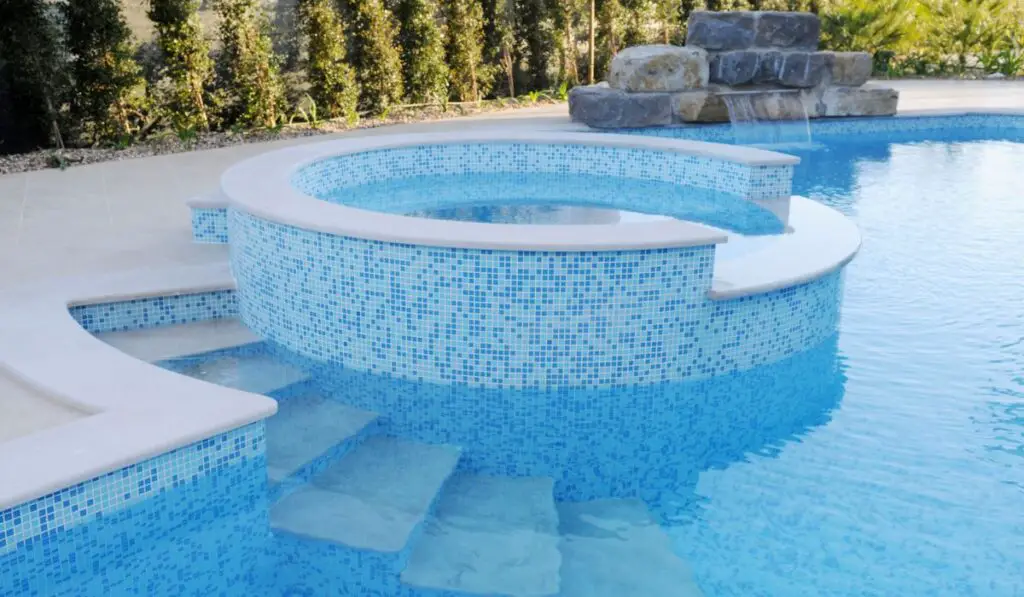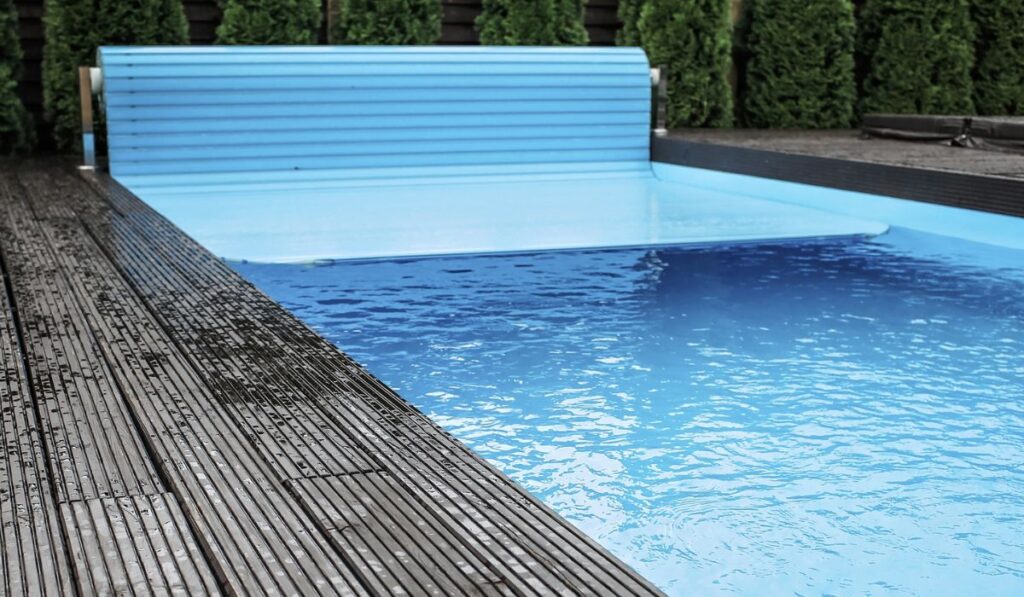Calcium buildup is an aspect almost every pool owner must deal with at some point in time. But these unsightly flakes can irritate your guests and pool filter, so how do you remove them?
There are two types of calcium buildup. Calcium carbonate, which is white, can be removed using a pumice stone or scaling treatment. Calcium silicate, which is gray, can only be removed using a pumice stone and can cause damage to your filter. If you have calcium silicate, call a professional.
Wondering how you can keep calcium from building up in the first place? Let’s look at what causes calcium buildup and how you can keep your pool clean and running smoothly for years to come.
What Causes Calcium Deposits on Pool Tiles?

Calcium deposits are a natural part of owning a pool. Calcium deposits form as a result of several factors.
The most common factor is when the chemicals in your pool are unbalanced. This creates the white powdery residue which is deposited on the tiles at the edge of the pool.
Even if you keep your pool water perfectly balanced, it is possible for calcium deposits to form. This is especially true when you live in a place with hard water and many hot days (like Las Vegas, Nevada).
Additionally, those who heat their pool because they live in colder locations, may also see calcium deposits start to form.
Why is Calcium Buildup Bad?
Calcium buildup might seem harmless, especially when you live in a location where it happens naturally due to hard water. But this buildup can actually cause damage to your pool and swimmers.
Calcium buildup can make its way into the eyes of guests and cause irritation. It can also sink to the bottom of your pool and flake off when people use your pool–also causing irritation to their skin.
Not to mention that calcium buildup can cause damage to your pool filter and other aspects of your pool–leading to costly repairs and needing to refinish your pool after just a few years of use!
What Are the Different Types of Calcium?
There are two types of calcium buildup that you may come across in your pool. It’s important to learn about both because they require different actions to remove from your pool.
Calcium Carbonate
Calcium carbonate is white and flaky and should brush off the tiles easily. Calcium carbonate is typically easy to remedy on your own and easy to remove.
Calcium Silicate
Calcium silicate is gray, and you’ll find it doesn’t brush off nearly as easily as calcium carbonate. Calcium silicate takes a while to build up, and may be a sign that there is more hidden damage to your pool in the pipes which you can’t see, or solve, on your own.
How to Tell Which is In Your Pool
The easiest way to tell what kind of calcium buildup you are experiencing is to place a few drops of muriatic acid (on Amazon) on the deposit and watch the reaction. Calcium carbonate will foam in reaction to the acid while calcium silicate will do nothing.
How Do You Remove Calcium Deposits From Pool Tiles?
Calcium Carbonate
If you have discovered calcium carbonate on your pool tiles, then you are in luck, as this type of calcium deposit is easy to remove. Grab a pumice stone (on Amazon) to rub the calcium away manually, or spray on a scale remover (on Amazon).
To prevent the pumice stone from scratching your tiles, keep the area wet as you scrub. Using a pumice stone is easy for smaller pools or those with calcium deposits near the water’s edge. Only use pumice stones on hard surfaces.
If you have calcium buildup on soft surfaces like your vinyl liner, then the scaling treatment is the best course of action. While some are applied once, others need to be applied several times, so read the instructions of the brand you purchase before using it in your pool.
You can also use a basic stain remover to remove calcium carbonate. Be cautious using too much of these, however, as the chemical could get in your pool and throw off the water pH balance. We recommend only using stain remover for small areas further from the pool edge.
Either way, after you finish removing the calcium carbonate it is recommended to double-check the chemical composition of your pool before using it once again.
Calcium Silicate
For those with calcium silicate buildup, you’ve got your work cut out for you. Unfortunately, a pumice stone and lots of scrubbing is the only way to get rid of calcium silicate.
If your pool has soft parts, like a vinyl liner, you cannot use a pumice stone. In these cases, it is best to contact a professional to find out what the next course of action is. It is also important to remember that calcium silicate could cause hidden damage to your filter and pipes which you can not remedy on your own.
Tips for Preventing Calcium Buildup
As you can see, it’s a bit annoying to get rid of calcium buildup once it’s in your pool. Therefore, you should take every step possible to prevent it from forming in the first place.
Here are our tips for preventing calcium buildup:
Lower Your pH Level
Calcium build-up is directly correlated to your pH level. While you want to make sure you still keep your pool at a safe level, keeping it as low as possible (while still safe) can help prevent calcium buildup.
Use a Pool Cover

Calcium buildup is often formed on a hot day when some of the water evaporates. By covering your pool with a cover whenever it isn’t in use you can help prevent evaporation and subsequent calcium formation. Plus, you won’t have to refill your pool as often either.
Use Reverse Osmosis
In some hot locations, calcium will continue to build up even if you follow all of the above. In these cases, it is recommended to use a reverse osmosis treatment regularly to help remove excess calcium from your water.
